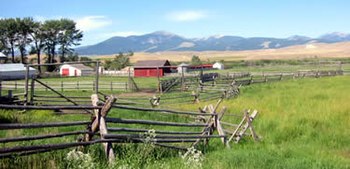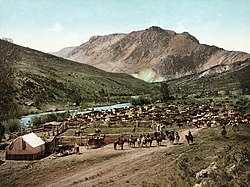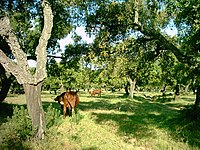Ranch

Aranch(fromSpanish:rancho/Mexican Spanish) is an area ofland,including various structures, given primarily toranching,the practice of raisinggrazinglivestocksuch ascattleandsheep.It is a subtype offarm.These terms are most often applied to livestock-raising operations inMexico,theWestern United StatesandWestern Canada,though there are ranches in other areas.[1][note 1]People who own or operate a ranch are calledranchers,cattlemen,orstockgrowers.Ranching is also a method used to raise less commonlivestocksuch ashorses,elk,American bison,ostrich,emu,andalpaca.[2]
Ranches generally consist of large areas, but may be of nearly any size. In the western United States, many ranches are a combination of privately owned land supplemented by grazing leases on land under the control of the federalBureau of Land Managementor theUnited States Forest Service.If the ranch includesarableorirrigated land,the ranch may also engage in a limited amount offarming,raising crops for feeding the animals, such ashayand feed grains.[2]
Ranches that cater exclusively to tourists are calledguest ranchesor, colloquially, "duderanches ". Most working ranches do not cater to guests, though they may allow privatehuntersoroutfittersonto their property to hunt native wildlife. However, in recent years,[when?]a few struggling smaller operations have added some dude ranch features such as horseback rides, cattle drives, and guided hunting to bring in additional income. Ranching is part of theiconographyof the "Wild West"as seen inWestern moviesandrodeos.
| Agriculture |
|---|
 |
|
|
Ranch occupations
[edit]
The person who owns and manages the operation of a ranch is usually called arancher,but the termscattleman,stockgrower,orstockmanare also sometimes used. If this individual in charge of overall management is an employee of the actual owner, the termforemanorranch foremanis used. A rancher who primarily raises young stock sometimes is called acow-calf operatoror acow-calf man.This person is usually the owner, though in some cases, particularly where there is absentee ownership, it is the ranch manager or ranch foreman.
The people who are employees of the rancher and involved in handling livestock are called a number of terms, includingcowhand,ranch hand,andcowboy.People exclusively involved with handling horses are sometimes calledwranglers.
Origins of ranching
[edit]Ranching and thecowboytradition originated inSpain,out of the necessity to handle large herds of grazing animals on dry land from horseback. During theReconquista,members of theSpanish nobilityand variousmilitary ordersreceived large land grants that theKingdom of Castilehadconquered from the Moors.These landowners were to defend the lands put into their control and could use them for earning revenue. In the process it was found that open-range breeding of sheep and cattle (under theMestasystem) was the most suitable use for vast tracts, particularly in the parts of Spain now known asCastilla-La Mancha,ExtremaduraandAndalusia.
History in North America
[edit]
When theConquistadorscame to theAmericasin the 16th century, followed by settlers, they brought theircattleand cattle-raising techniques with them. Huge land grants by the Spanish (and later Mexican) government, part of thehaciendasystem, allowed large numbers of animals to roam freely over vast areas. A number of different traditions developed, often related to the original location in Spain from which a settlement originated. For example, many of the traditions of theJaliscocharrosin central Mexico come from theSalamancacharrosof Castile.[citation needed]Thevaquerotradition of Northern Mexico was more organic, developed to adapt to the characteristics of the region from Spanish sources by cultural interaction between the Spanish elites and the native andmestizopeoples.[3]
Cattle ranchingflourished in Spanish Floridaduring the 17th century.[4]

The word "Rancho" in Mexico developed different definitions from what it originally meant in Spain. In the book "Descripción de la Diócesis de Guadalajara de Indias" (1770),Mateo José de Arteagadefined "Ranchos" as "extensions of land where few people live with few assets and sheltering in huts."[5]In 1778,José Alejandro Patiño,in his text "Topografía del Curato de Tlaxomulco," defined Ranchos as "some country houses of little pomp and value, in which poor and middle-class men live, cultivating the small lands that they have or lease in which to sow according to the size of each of their possibilities and raising their domestic rural animals according to their strength."[6][7]
By the nineteenth century, the words Rancho and Estancia as used in Mexico had been consolidated to define a unit of land that made up aHaciendaor any rural area or the countryside in general. Domingo Revilla in 1844, in his text "Los Rancheros", defined a Rancho or Estancia as "a unit of land which comprises a Hacienda, where cattle and horses are raised, and which is in the care of a Caporal who is the captain of the other cowboys."[8]Niceto de Zamacois,in his book "Historia de Méjico" (1879), defined terms as follows: "...the men of the countryside who carry out their jobs on horseback are given the name of" Rancheros, "derived from the word Rancho that is applied to a small hacienda, or to a part of a large one that is divided into racherias or ranchos. Those who carry out the same tasks in the haciedas of Veracruz are given the name of" Jarochos. "[9]
Thus the term Rancho inMexican Spanishbecame a unit of land that makes up a hacienda where cattle is raised and where people live in farmhouses. The people that live and work in those Ranchos managing cattle and horses are called Rancheros.[10]
United States
[edit]
As settlers from theUnited Statesmoved west, they brought cattle breeds developed on the east coast and inEuropealong with them, and adapted their management to the drier lands of the west by borrowing key elements of the Spanishvaqueroculture.

However, there were cattle on the eastern seaboard.Deep Hollow Ranch,110 miles (180 km) east ofNew York CityinMontauk, New York,claims to be the first ranch in the United States, having continuously operated since 1658.[11]The ranch makes the somewhat debatable claim of having the oldest cattle operation in what today is the United States, though cattle had been run in the area since European settlers purchased land from theIndian peopleof the area in 1643.[12]Although there were substantial numbers of cattle on Long Island, as well as the need to herd them to and from common grazing lands on a seasonal basis, the cattle handlers actually lived in houses built on the pasture grounds, and cattle were ear-marked for identification, rather than being branded.[12]The only actual "cattle drives" held on Long Island consisted of one drive in 1776, when the island's cattle were moved in a failed attempt to prevent them from being captured during theRevolutionary War,and three or four drives in the late 1930s, when area cattle were herded down Montauk Highway to pasture ground near Deep Hollow Ranch.[12]
The open range
[edit]
Theprairieanddesertlands of what today isMexicoand the westernUnited Stateswere well-suited to "open range"grazing. For example,American bisonhad been a mainstay of the diet for theNative Americansin the Great Plains for centuries. Likewise, cattle and other livestock were simply turned loose in the spring after their young were born and allowed to roam with little supervision and no fences, then rounded up in the fall, with the mature animals driven to market and the breeding stock brought close to the ranch headquarters for greater protection in the winter. The use oflivestock brandingallowed the cattle owned by different ranchers to be identified and sorted. Beginning with the settlement ofTexasin the 1840s, and expansion both north and west from that time, through theCivil Warand into the 1880s, ranching dominated western economic activity.
Along with ranchers came the need for agricultural crops to feed both humans and livestock, and hence manyfarmersalso came west along with ranchers. Many operations were "diversified", with both ranching and farming activities taking place. With theHomestead Actof 1862, more settlers came west to set upfarms.This created some conflict, as increasing numbers of farmers needed to fence off fields to prevent cattle and sheep from eating their crops.Barbed wire,invented in 1874, gradually made inroads in fencing off privately owned land, especially for homesteads. There was some reduction of land on theGreat Plainsopen to grazing.
End of the open range
[edit]
The end of the open range was not brought about by a reduction in land due tocrop farming,but byovergrazing.Cattle stocked on the open range created atragedy of the commonsas each rancher sought increased economic benefit by grazing too many animals onpublic landsthat "nobody" owned. However, being a non-native species, the grazing patterns of ever-increasing numbers of cattle slowly reduced the quality of the rangeland, in spite of the simultaneous massive slaughter ofAmerican bisonthat occurred. Thewinter of 1886–87was one of the most severe on record, and livestock that were already stressed by reduced grazing died by the thousands. Many large cattle operations went bankrupt, and others suffered severe financial losses. Thus, after this time, ranchers also began to fence off their land and negotiated individual grazing leases with the American government so that they could keep better control of the pasture land available to their own animals.
Ranching in Hawaii
[edit]Ranching inHawaiideveloped independently of that in the continental United States. In colonial times, Capt.George Vancouvergave several head of cattle to the Hawaiian king,Pai`ea Kamehameha,monarch of the Hawaiian Kingdom, and by the early 19th century, they had multiplied considerably, to the point that they were wreaking havoc throughout the countryside. About 1812, John Parker, a sailor who had jumped ship and settled in the islands, received permission from Kamehameha to capture the wild cattle and develop a beef industry.
The Hawaiian style of ranching originally included capturing wild cattle by driving them into pits dug in the forest floor. Once tamed somewhat by hunger and thirst, they were hauled out up a steep ramp, and tied by their horns to the horns of a tame, older steer (orox) and taken to fenced-in areas. The industry grew slowly under the reign of Kamehameha's son Liholiho (Kamehameha II). When Liholiho's brother, Kauikeaouli (Kamehameha III), visitedCalifornia,then still a part ofMexico,he was impressed with the skill of the Mexicanvaqueros.In 1832, he invited several to Hawaii to teach the Hawaiian people how to work cattle.
TheHawaiiancowboy came to be called thepaniolo,aHawaiianizedpronunciation ofespañol.Even today, the traditional Hawaiian saddle and many other tools of the ranching trade have a distinctly Mexican look, and many Hawaiian ranching families still carry the surnames of vaqueros who made Hawaii their home.
Ranching in South America
[edit]InArgentinaandUruguay,ranches are known asestanciasand inBrazil,they are calledfazendas.In much ofSouth America,includingEcuadorandColombia,the termhaciendaorfincamay be used.RancheroorRanchoare also generic terms used throughout tropicalLatin America.
In the colonial period, from thepampasregions ofSouth Americaall the way to theMinas Geraisstate in Brazil, including thesemi-arid pampasofArgentinaand the south of Brazil, were often well-suited to ranching, and a tradition developed that largely paralleled that of Mexico and the United States. Thegauchoculture ofArgentina,BrazilandUruguayare among the cattle ranching traditions born during the period. However, in the 20th century, cattle raising expanded into less-suitable areas of thePantanal.Particularly inBrazil,the 20th century marked the rapid growth ofdeforestation,asrain forestlands were cleared byslash and burnmethods that allowed grass to grow for livestock, but also led to the depletion of the land within only a few years. Many ofindigenous peoplesof the rain forest opposed this form of cattle ranching and protested the forest being burnt down to set up grazing operations and farms. This conflict is still a concern in the region today.
Ranches outside the Americas
[edit]
In Spain, where the origins of ranching can be traced, there areganaderíasoperating ondehesa-type land, wherefighting bullsare raised. However, ranch-type properties are not seen to any significant degree in the rest of westernEurope,where there is far less land area and sufficient rainfall allows the raising ofcattleon much smaller farms.
InAustralia,a rangeland property is astation(originally in the sense of a place where stock were temporarily stationed). In almost all cases, these are eithercattle stationsorsheep stations.The largest cattle stations in the world are located in Australia's dryoutbackrangelands. Owners of these stations are usually known asgraziersor pastoralists, especially if they reside on the property. Employees are usually known asstockmen/stockwomen,jackaroos/jillaroosand/or ringers (rather than cowboys). A number of Australian cattle stations are larger than 10,000 km2,with the greatest beingAnna Creek Stationwhich measures 23,677 km2in area (approximately eight times the largest US Ranch). Anna Creek is owned byS Kidman & Co.
The equivalent terms inNew Zealandarerunandstation.
InSouth Africa,similar large holdings are usually known as a farm (occasionally also ranch) inSouth African EnglishandplaasinAfrikaans.
See also
[edit]- Animal husbandry
- Cattle station
- Garden tools
- Estancia
- Holistic management
- Homestead (buildings)
- Intensive animal farming § Cattle
- List of Ranches and Stations
- Movie ranch
- Pastoralism
- Ranch school
- Ranch-style house
- Sheep station
References
[edit]- ^Spiegal, S., Huntsinger, L., Starrs, P.F., Hruska, T., Schellenberg, M.P., McIntosh, M.M., 2019. Rangeland livestock production in North America, in: Squires, V.R., Bryden, W.L. (Eds.), Livestock: Production, Management Strategies, and Challenges. NOVA Science Publishers, New York, New York, USA.
- ^abHolechek, J.L., Geli, H.M., Cibils, A.F. and Sawalhah, M.N., 2020. Climate Change, Rangelands, and Sustainability of Ranching in the Western United States.Sustainability,12(12), p.4942.
- ^Haeber, Jonathan."Vaqueros: The First Cowboys of the Open Range".National Geographic News,August 15, 2003. Accessed online October 15, 2007.
- ^Arnade, Charles W. (1961)."Cattle Raising in Spanish Florida, 1513-1763".Agricultural History.35(3): 116–124.ISSN0002-1482.JSTOR3740622.
- ^Serrera Contreras, Ramon María (1977).Guadalajara ganadera estudio regional novohispano, 1760-1805(in Spanish). Sevilla, Spain: Escuela de Estudios Hispano-Americanos. p. 33.ISBN9788400036959.
- ^Gomez Serrano, Jesús (2000).Haciendas y ranchos de Aguascalientes estudio regional sobre la tenencia de la tierra y el desarrollo agrícola en el siglo XIX(in Spanish). Mexico: Universidad Autónoma de Aguascalientes. p. 61.ISBN9789685073059.Retrieved23 February2022.
- ^Serrera Contreras, Ramon María (1977).Guadalajara ganadera estudio regional novohispano, 1760-1805(in Spanish). Sevilla, Spain: Escuela de Estudios Hispano-Americanos. p. 33.ISBN9788400036959.
- ^Revilla, Domingo (1844).El museo mexicano o miscelánea de amenidades curiosas e instructivas Volume 3(Volume 3 ed.). Mexico City: Ignacio Cumplido. p. 557.Retrieved23 February2022.
- ^de Zamacois, Niceto (1879).Historia de Méjico desde sus tiempos mas remotos hasta nuestros dias Volume 10(Volume 10 ed.). Barcelona and Mexico: J.F. Párres y compañia. p. 61.Retrieved23 February2022.
- ^Domínguez, Ramon Joaquin (1856).Diccionario nacional ó gran diccionario clásico de la lengua Española.Vol. 2. Madrid, Paris: Mellado. p. 268.Retrieved23 February2022.
- ^Deep Hollow Ranch HistoryArchived2007-11-22 at theWayback Machine
- ^abcOchs, Ridgeley. "Ride 'em, Island Cowboy,"Newsday,.Accessed May 5, 2008
Notes
[edit]- ^For terminologies in Australia and New Zealand, seeStation (Australian agriculture)andStation (New Zealand agriculture).
Further reading
[edit]- Blunt, Judy(2002).Breaking Clean.Knopf.ISBN0-375-40131-8.
- Campbell, Ida Foster; Hill, Alice Foster (2002).Triumph and Tragedy: A History of Thomas Lyons and the LCs.Silver City, New Mexico: High-Lonesome Books.ISBN0-944383-61-0.
- Ellis, George F.(1973).The Bell Ranch as I Knew It.Lowell Press.ISBN0-913504-15-7.
- Greenwood, Kathy L. (1989).Heart-Diamond.University of North Texas Press.ISBN0-929398-08-4.
- Paul, Virginia (1973).This Was Cattle Ranching: Yesterday and Today.Seattle, Washington: Superior.
- Ward, Delbert R. (1993).Great Ranches of the United States.San Antonio, Texas: Ganada Press.ISBN1-88051-025-1.
External links
[edit]- The Canadian Museum of Civilization - Native Ranching and Rodeo Life on the Plains and Plateau
- The Handbook of Texas Online:Ranching
- Cattle Ranges of the Southwest,published 1898, hosted by the Portal to Texas History
- Guide to ranch archives in Southwest Collection/Special Collections Library at Texas Tech
- Cowboys to Cattlemen Virtual Museum Exhibit and Lesson Plans at Grant-Kohrs Ranch NHSfromNational Park Service
